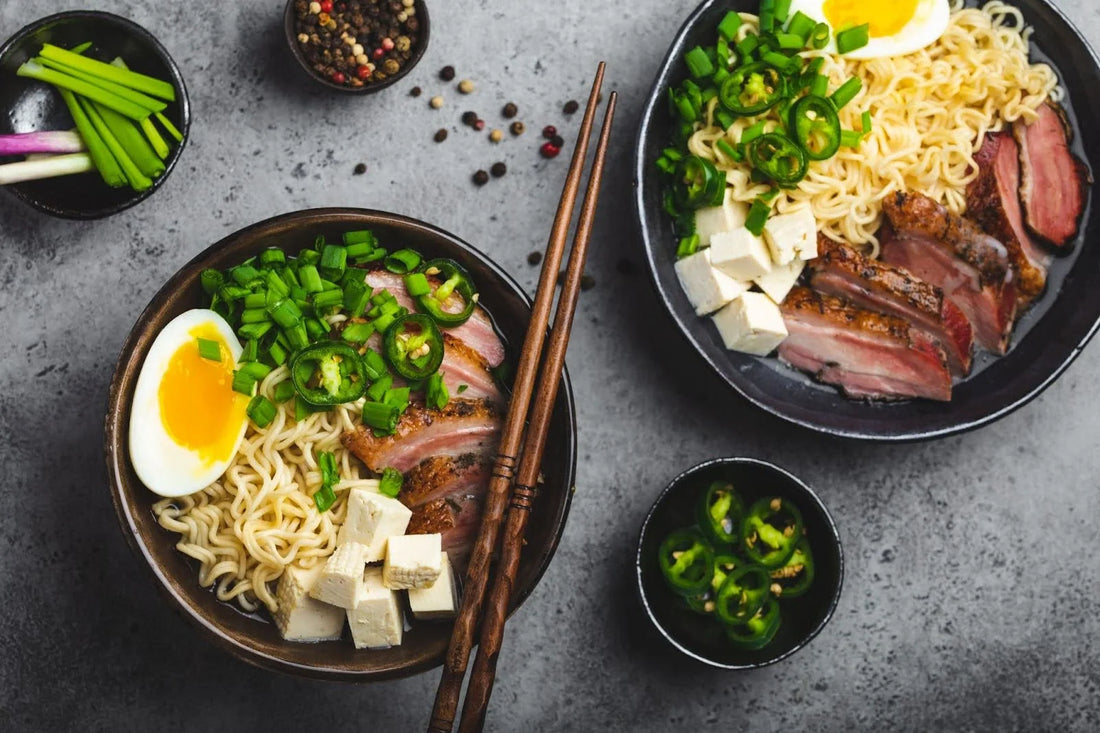
Which Vegetables Make Your Ramen Soup Extra Delicious?
Teilen
Steam rises from the bowl as the aromatic broth meets your senses, promising warmth and satisfaction in every spoonful. Ramen soup has transformed from a simple Japanese street food into a global comfort phenomenon that speaks to food lovers across cultures. What makes this humble dish so captivating lies not just in its silky noodles or rich, umami-packed broth, but in the colorful array of vegetables that crown each bowl.
When considering which vegetables work best, the answer depends on the desired flavor profile and dining experience. These plant-based additions bring crucial elements that elevate the entire dining experience – from providing textural contrast to the soft noodles, to adding bursts of color and essential nutrients that transform a simple meal into something extraordinary.

Why Vegetables Matter in Ramen Soup
The inclusion of vegetables in ramen soup serves multiple crucial purposes that extend far beyond simple garnishing. Understanding these roles helps explain why vegetables have become such an integral part of authentic ramen preparation.
Balancing Flavors and Textures
Vegetables bring essential balance to what could otherwise become an overwhelmingly rich meal. Ramen broths, particularly tonkotsu and miso varieties, tend to be dense with fats and intense flavors. Fresh vegetables provide cleansing, bright notes that prevent palate fatigue and keep diners engaged throughout the meal.
The textural variety that vegetables introduce cannot be overstated. While ramen noodles offer a satisfying chewiness and broth provides liquid comfort, vegetables contribute everything from crisp snap to tender bite. This textural diversity keeps each spoonful interesting and prevents the monotony that can occur with single-texture meals.
Different vegetables also contribute varying levels of natural sweetness, bitterness, and earthiness. These flavor compounds interact with the soup's existing taste profile, creating layers of complexity that make each bowl more sophisticated and satisfying than the sum of its parts.
Nutritional Benefits
Modern diners increasingly seek meals that provide both satisfaction and nutritional value, making the role of vegetables in ramen soup particularly important. Fresh vegetables contribute essential vitamins, minerals, and fiber that transform ramen from a simple carbohydrate-heavy meal into something more nutritionally complete.
Dark leafy greens like spinach provide iron and folate, while colorful vegetables contribute antioxidants and vitamin C. The addition of vegetables also increases the meal's fiber content, promoting better digestion and helping diners feel satisfied for more extended periods.
Essential Vegetables for Classic Ramen Soup
When exploring which vegetables for ramen soup create the most authentic experience, several vegetables stand out as fundamental components that appear across different regional ramen styles.
Top Traditional Choices
- Napa Cabbage - This mild, tender cabbage variety has become synonymous with quality ramen preparation. Napa cabbage provides a subtle sweetness and satisfying crunch without overwhelming the broth's delicate balance. Its leaves cook quickly, maintaining some texture while absorbing the surrounding flavors beautifully.
- Spinach - Fresh spinach leaves wilt perfectly in hot broth, contributing iron-rich nutrition and a pleasant, mild earthiness. The bright green color creates visual appeal while the tender texture complements ramen noodles perfectly. Spinach works particularly well in lighter, clearer broths where its subtle flavor can shine.
- Green Onions and Scallions - Perhaps the most universal ramen vegetable, green onions provide a sharp, fresh flavor that cuts through rich broths effectively. Both the white and green portions offer different taste experiences – the whites bringing mild onion flavor while the greens contribute color and a sharper bite.
Mushroom Varieties

- Shiitake Mushrooms - These umami powerhouses add deep, savory complexity that enhances the broth's existing flavors. Shiitake mushrooms provide a meaty texture that makes ramen soup more substantial and satisfying.
- Enoki Mushrooms - With their delicate texture and mild flavor, enoki mushrooms add visual interest and a subtle earthiness. Their thin, noodle-like appearance creates an interesting textural parallel to the ramen noodles themselves.
Additional Vegetables to Enhance Ramen Soup
Beyond traditional choices, numerous other vegetables can elevate your selection of vegetables for ramen soup, allowing for creative customization and regional adaptations.
Colorful Additions
- Carrots - Julienned carrots bring natural sweetness and vibrant orange color to the bowl. They maintain a pleasant crunch when added near the end of cooking, providing textural contrast and visual appeal.
- Bamboo Shoots - These provide a unique, slightly crunchy texture with a clean, fresh flavor. Bamboo shoots are traditional in many regional ramen styles and add authenticity to homemade versions.
- Corn Kernels - Popular in Hokkaido-style ramen, corn contributes sweetness and a bright yellow color. The kernels provide pleasant pops of flavor and interesting textural variation.
Cruciferous Options
Broccoli and Broccoli Rabe: These vegetables bring bold, slightly bitter flavors that pair excellently with rich, fatty broths. The small florets cook quickly and maintain good texture, while contributing significant nutritional value.
Bok Choy: This Asian green offers both tender leaves and crunchy stems, providing dual textures in a single vegetable. Its mild flavor works well across different broth types.
Tips for Cooking Vegetables for Ramen Soup

Proper vegetable preparation can make the difference between mediocre and exceptional ramen soup. The key lies in understanding how different vegetables respond to heat and timing their addition appropriately.
Preserving Texture and Flavor
Different vegetables require different cooking approaches. Hardy vegetables like carrots and broccoli benefit from brief blanching before adding to the broth, while delicate greens like spinach should be added just before serving to prevent overcooking.
Temperature control plays a crucial role in maintaining vegetable quality. Adding vegetables to violently boiling broth can break down their cell structure too quickly, resulting in mushy textures and diminished flavors. Instead, maintain a gentle simmer when incorporating vegetables.
Seasoning and Balancing Flavors
Consider the natural flavors each vegetable contributes when determining which ones will work best in your specific ramen soup recipe. Sweet vegetables like corn and carrots pair excellently with spicy or salty broths, while bitter vegetables like broccoli rabe complement rich, fatty bases.
Pre-seasoning certain vegetables can enhance their contribution to the overall flavor profile. A light toss with salt can help draw out excess moisture from vegetables like cabbage, concentrating their flavors and improving their texture in the finished dish.
Creating Your Perfect Vegetable Combination
The vegetables you choose can transform a simple bowl of ramen soup into a complete, satisfying meal that nourishes both body and soul. From the traditional crunch of napa cabbage to the umami depth of shiitake mushrooms, each vegetable brings its own exceptional contribution to the final dish.
Whether you prefer the classic simplicity of green onions and spinach or enjoy exploring bold combinations with corn, bamboo shoots, and broccoli, the key lies in understanding how each vegetable interacts with your chosen broth and noodles. Experimenting with different vegetables for ramen soup combinations allows you to discover new flavor profiles and create signature bowls that reflect your personal taste preferences.

